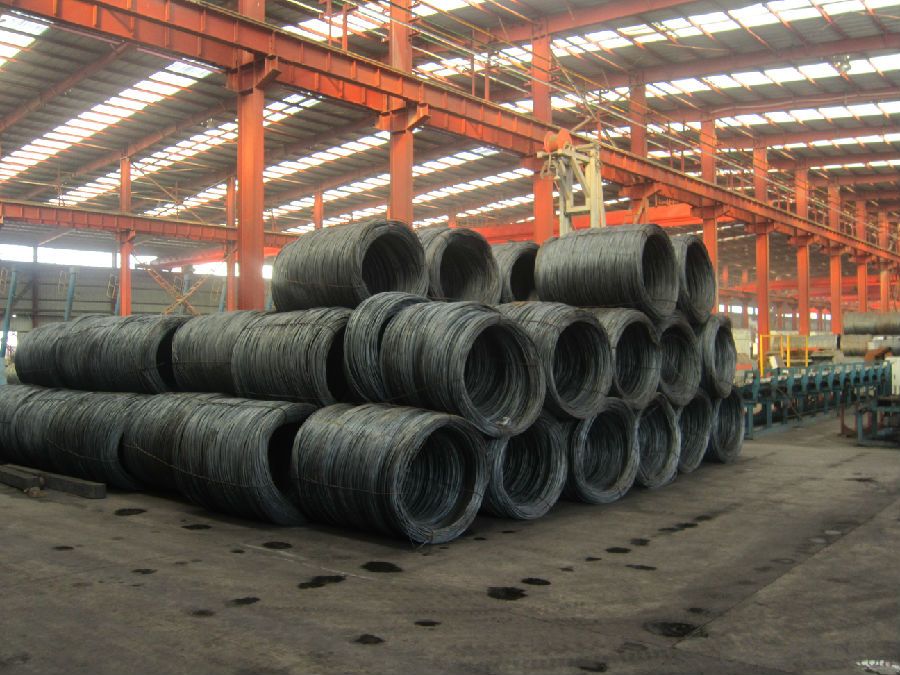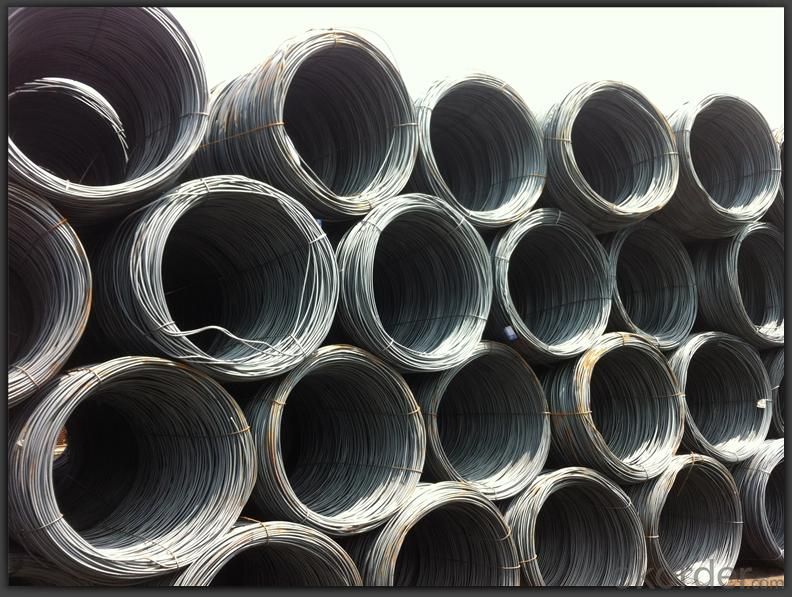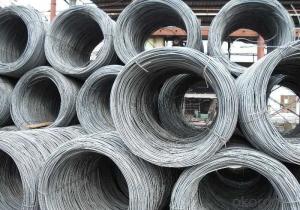Wire Rod Hot Rolled High Quality SAE1008 and SAE1006
- Loading Port:
- Tianjin
- Payment Terms:
- TT OR LC
- Min Order Qty:
- 25 m.t.
- Supply Capability:
- 200000 m.t./month
OKorder Service Pledge
OKorder Financial Service
You Might Also Like
Product Description:
OKorder is offering high quality Hot Rolled Steel I-Beams at great prices with worldwide shipping. Our supplier is a world-class manufacturer of steel, with our products utilized the world over. OKorder annually supplies products to European, North American and Asian markets. We provide quotations within 24 hours of receiving an inquiry and guarantee competitive prices.
Product Applications:
After hot-rolled the products shaped into coil and delivery as finished product, including round, square, rectangular, hexagonal and so on. Since most of the products are round, it is generally called wire rod. Carbon steel wire rod is widely used in construction and manufacturing. Carbon steel wire rod is mainly used for reinforcement of reinforced concrete and welded structure or reprocessed (roberts , nail, etc.) materials, especially used to produce wire drawing, welding electrode, nails, spring, electronic, precise machinery parts and so on.
Product Advantages:
OKorder's Wire Rod Hot Rolled High Quality SAE1008 and SAE1006 are durable, strong, and resist corrosion.
Main Product Features:
· Premium quality
· Prompt delivery & seaworthy packing (30 days after receiving deposit)
· Corrosion resistance
· Can be recycled and reused
· Mill test certification
· Professional Service
· Competitive pricing
Product Specifications:
Manufacture: Hot rolled
Grade: SAE1008 SAE 1006
Certificates: ISO, SGS, BV, CIQ
Diameter: 5.5mm, 6.5mm, 7mm,8mm,9mm,10mm,12mm,14mm, as per customer request
Packaging: Export packing, nude packing, bundled
Grade | Chemical Composition (%) | |||||
C | Mn | S | P | Si | B | |
SAE1008B | 0.10max | 0.32max | 0.045max | 0.040max | 0.30max | 0.0008min |
Mechanical properties | ||||||
Yield strength(N/mm2) | Tensile strength(N/mm2) | Elongation (%) | ||||
≥195 | 350-380 | ≥32 | ||||
FAQ:
Q1: Why buy Materials & Equipment from OKorder.com?
A1: All products offered byOKorder.com are carefully selected from China's most reliable manufacturing enterprises. Through its ISO certifications, OKorder.com adheres to the highest standards and a commitment to supply chain safety and customer satisfaction.
Q2: How do we guarantee the quality of our products?
A2: We have established an advanced quality management system which conducts strict quality tests at every step, from raw materials to the final product. At the same time, we provide extensive follow-up service assurances as required.
Q3: How soon can we receive the product after purchase?
A3: Within three days of placing an order, we will begin production. The specific shipping date is dependent upon international and government factors, but is typically 7 to 10 workdays.


- Q:What are the common packaging materials used for steel wire rod coils?
- The common packaging materials used for steel wire rod coils include wooden pallets, steel strapping, plastic wrapping, and metal sheets. Wooden pallets are often used as a base to stack and store the coils, providing stability and easy handling during transportation. Steel strapping is used to secure the coils tightly together, preventing any movement or damage during transit. Plastic wrapping is commonly used to provide additional protection against moisture and dust, ensuring the coils remain in optimal condition. Metal sheets are sometimes placed on top of the coils to provide extra protection and prevent any external damage. These packaging materials are essential for ensuring the safe and efficient handling, storage, and transportation of steel wire rod coils.
- Q:What are the major innovations in steel wire rod production technology?
- Steel wire rod production technology has undergone several significant advancements in recent years, greatly enhancing the efficiency, quality, and sustainability of the production process. One notable innovation is the adoption of continuous casting technology. In the past, steel wire rods were produced using a batch process, where molten steel was poured into individual molds and allowed to solidify before being cut into rods. However, continuous casting enables a continuous flow of molten steel to solidify into long strands. This eliminates the need for individual molds and increases the speed and productivity of production. Another important advancement is the utilization of high-speed rolling mills. These mills are equipped with advanced technologies that allow for faster rolling speeds and higher production rates. By using high-speed rolling mills, the output of steel wire rods can be increased, while also improving the quality and consistency of the final product. Moreover, the development of automation and digital technologies has revolutionized steel wire rod production. Automated systems and robotics now control various stages of the production process, from raw material handling to finished product packaging. This reduces the risk of human error and enhances overall efficiency and productivity. Furthermore, there have been significant advancements in metallurgy, resulting in the production of stronger and more durable steel wire rods. Manufacturers can now produce rods with superior mechanical properties, such as higher tensile strength and improved resistance to corrosion and fatigue, through the use of advanced alloys and heat treatment processes. Lastly, there has been a growing emphasis on sustainability in steel wire rod production. The industry has made strides in energy-efficient technologies and waste reduction strategies, leading to significant improvements in environmental impact. Energy recovery systems and the incorporation of recycled materials in the production process have reduced energy consumption and minimized waste generation. In summary, major innovations in steel wire rod production technology encompass continuous casting, high-speed rolling mills, automation and digital technologies, advancements in metallurgy, and a heightened focus on sustainability. These innovations have not only enhanced the efficiency and quality of steel wire rod production but have also contributed to a more sustainable and environmentally friendly industry.
- Q:How is steel wire rod used in the manufacturing of suspension springs?
- Steel wire rod is used in the manufacturing of suspension springs as it provides the necessary strength and durability required to withstand the weight and impact of a vehicle. The wire rod is typically coiled and then formed into the desired shape, creating a resilient and flexible component that can absorb shocks and vibrations while maintaining stability and support in the suspension system.
- Q:How are steel wire rods used in the production of fishing nets for catching fish?
- Steel wire rods are used in the production of fishing nets for catching fish as they provide strength and durability to the net structure. These rods are typically woven or twisted together to form the main framework of the net, ensuring it can withstand the weight and force of the fish caught. Additionally, the steel wire rods help maintain the shape and flexibility of the net, allowing for effective fishing operations.
- Q:How is steel wire rod used in the production of wire mesh for mining and quarrying applications?
- Steel wire rod is used in the production of wire mesh for mining and quarrying applications as it provides the necessary strength and durability required for these demanding environments. The wire rod is first drawn into the desired gauge and then woven or welded together to create the wire mesh. This mesh is used as a protective barrier or screening material to prevent debris, rocks, or other materials from entering mining or quarrying equipment, ensuring safe and efficient operations. Additionally, the steel wire rod's high tensile strength allows the wire mesh to withstand heavy loads and impacts, making it an ideal choice for these rugged applications.
- Q:What are the main challenges in steel wire rod production?
- Manufacturers typically encounter several primary challenges in the production of steel wire rods. One of these challenges involves the need to maintain consistent quality and uniformity in the wire rod products. Given that these products are utilized in various sectors like construction, automotive, and manufacturing industries, it becomes crucial to adhere to strict quality control measures that align with the specific requirements and standards of each sector. Another significant challenge lies in optimizing the production process to achieve high productivity and efficiency. The production of steel wire rods encompasses multiple stages, including melting, casting, rolling, and finishing. Each stage necessitates appropriate equipment, skilled operators, and precise control to minimize downtime, decrease waste, and maximize output. Manufacturers must continuously analyze and refine their production processes to attain optimal efficiency. Moreover, the global steel industry confronts environmental challenges, such as the reduction of energy consumption, minimization of carbon emissions, and implementation of sustainable practices. The production of steel wire rods consumes substantial energy, particularly during the melting and rolling processes. Manufacturers are constantly exploring innovative technologies and methods to enhance energy efficiency, recycle waste materials, and diminish the environmental impact of their operations. Supply chain management also poses a critical challenge in steel wire rod production. Manufacturers must ensure a steady supply of raw materials, including iron ore and scrap metal, while establishing strong relationships with suppliers. Additionally, they must efficiently manage logistics to ensure prompt and reliable delivery of finished products to customers. Lastly, the steel wire rod market is fiercely competitive, with numerous domestic and international players. Manufacturers must consistently innovate and adapt to market trends, customer demands, and changing regulations to remain competitive. They must invest in research and development, product diversification, and marketing strategies to differentiate themselves and maintain a robust market position. In summary, the primary challenges in steel wire rod production revolve around quality control, production efficiency, environmental sustainability, supply chain management, and market competitiveness. Overcoming these challenges necessitates continual improvement, technological advancements, and strategic decision-making to ensure success in this demanding industry.
- Q:What are the different types of steel wire rod available?
- There are several different types of steel wire rods available, each with its own unique properties and applications. Some of the common types include carbon steel wire rods, alloy steel wire rods, stainless steel wire rods, and galvanized steel wire rods. Carbon steel wire rods are the most widely used type and are known for their high strength and durability. They are often used in construction, automotive, and manufacturing industries for applications such as reinforcing concrete, making wire mesh, and producing springs and fasteners. Alloy steel wire rods contain additional elements like chromium, nickel, or molybdenum, which enhance their strength, hardness, and resistance to corrosion. These rods are commonly used in the production of high-strength wires, cables, and springs that require superior performance under demanding conditions. Stainless steel wire rods are highly corrosion-resistant and have excellent strength and heat resistance properties. They are commonly used in applications where hygiene, durability, and aesthetics are important, such as in the production of kitchen utensils, medical instruments, and architectural structures. Galvanized steel wire rods are coated with a layer of zinc to provide enhanced corrosion resistance. This type of wire rod is commonly used in outdoor and marine applications, such as fencing, electrical wiring, and fishnets, where exposure to moisture and harsh environments is a concern. In addition to these types, there are also specialty steel wire rods available, such as oil-tempered wire rods used in the production of automotive suspension springs, and cold-heading quality wire rods used for manufacturing fasteners and screws. Overall, the availability of different types of steel wire rods allows for a wide range of applications across various industries, providing strength, durability, and resistance to corrosion as required by specific needs.
- Q:What are the different types of steel wire rod annealing atmospheres?
- There are several different types of steel wire rod annealing atmospheres that can be used depending on the desired outcome and specific requirements of the process. These atmospheres can vary in terms of the gases used and the conditions maintained during annealing. 1. Nitrogen Atmosphere: Nitrogen gas is commonly used in steel wire rod annealing processes. It is an inert gas that helps to protect the material from oxidation and decarburization. Nitrogen atmosphere creates a stable environment for annealing, ensuring consistent and controlled heat treatment. 2. Hydrogen Atmosphere: Hydrogen gas is another commonly used annealing atmosphere for steel wire rods. Hydrogen helps to minimize surface oxidation and can also aid in the removal of any surface contaminants or impurities. It promotes a clean and bright surface finish on the wire rod. 3. Vacuum Atmosphere: Vacuum annealing involves creating a low-pressure environment by removing air and other gases from the annealing chamber. This atmosphere prevents oxidation and allows for precise control over the annealing process. Vacuum annealing is often used for high-quality wire rods that require minimal surface defects and improved mechanical properties. 4. Inert Gas Mixtures: In some cases, a mixture of inert gases such as nitrogen and hydrogen may be used as an annealing atmosphere. This combination can provide the benefits of both gases, such as protection against oxidation and impurity removal. The specific mixture and ratios are determined based on the desired outcome and material requirements. 5. Controlled Atmosphere Furnaces: Controlled atmosphere furnaces allow for precise regulation of the annealing atmosphere by continuously monitoring and adjusting the gas composition. This enables the optimization of annealing conditions to achieve desired material properties and surface finishes. It is important to note that the choice of annealing atmosphere depends on the specific steel composition, desired properties, and end-use application of the wire rod. By carefully selecting the appropriate atmosphere, steel wire rods can undergo a controlled heat treatment process that enhances their mechanical properties, surface quality, and overall performance.
- Q:How is steel wire rod transported and stored?
- Steel wire rod is typically transported and stored in large coils or bundles. These coils are loaded onto trucks, trains, or ships for transportation to various destinations. When it comes to storage, steel wire rod is often stacked in warehouses or outdoor yards, with proper measures taken to ensure stability and prevent damage. Additionally, the coils can be stored on racks or placed on flat surfaces to maintain their shape and prevent tangling.
- Q:How is the quality of steel wire rod determined?
- The quality of steel wire rod is determined through various tests and inspections that assess its chemical composition, mechanical properties, surface condition, and dimensional accuracy. These evaluations include analyzing the steel's carbon content, tensile strength, hardness, and ductility. Additionally, visual inspections are conducted to check for surface defects, such as cracks, scratches, or rust. Dimensional measurements are also taken to ensure the wire rod meets the required specifications.
1. Manufacturer Overview |
|
|---|---|
| Location | |
| Year Established | |
| Annual Output Value | |
| Main Markets | |
| Company Certifications | |
2. Manufacturer Certificates |
|
|---|---|
| a) Certification Name | |
| Range | |
| Reference | |
| Validity Period | |
3. Manufacturer Capability |
|
|---|---|
| a)Trade Capacity | |
| Nearest Port | |
| Export Percentage | |
| No.of Employees in Trade Department | |
| Language Spoken: | |
| b)Factory Information | |
| Factory Size: | |
| No. of Production Lines | |
| Contract Manufacturing | |
| Product Price Range | |
Send your message to us
Wire Rod Hot Rolled High Quality SAE1008 and SAE1006
- Loading Port:
- Tianjin
- Payment Terms:
- TT OR LC
- Min Order Qty:
- 25 m.t.
- Supply Capability:
- 200000 m.t./month
OKorder Service Pledge
OKorder Financial Service
Similar products
New products
Hot products
Related keywords



























